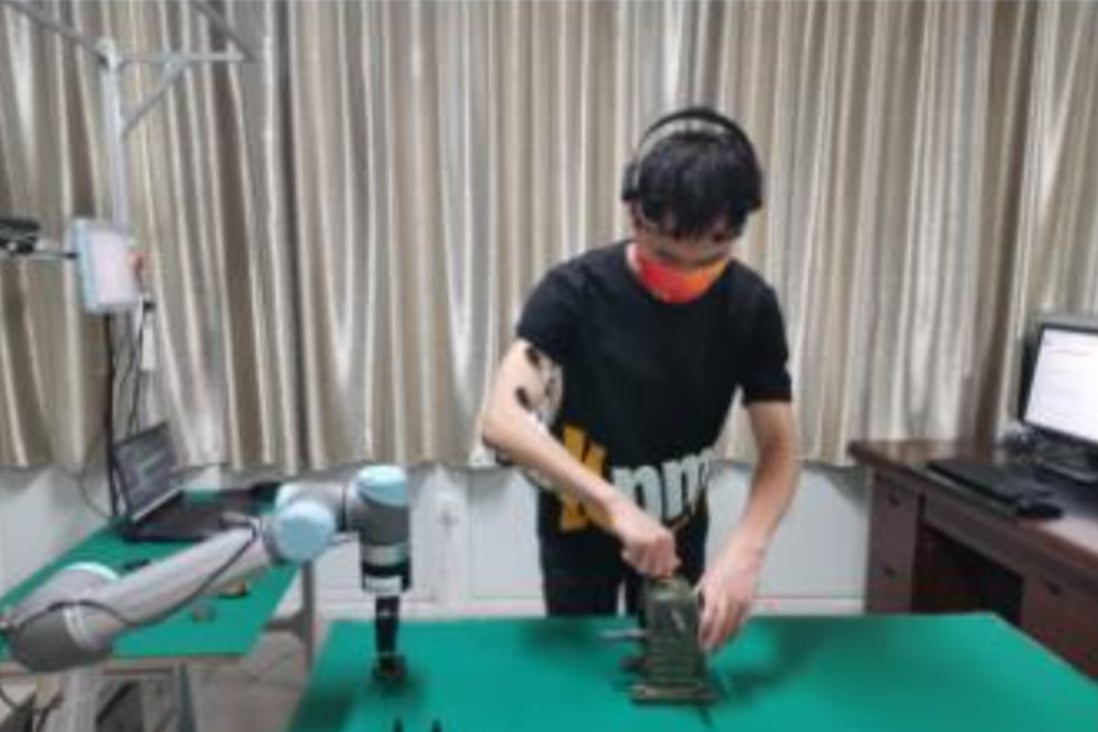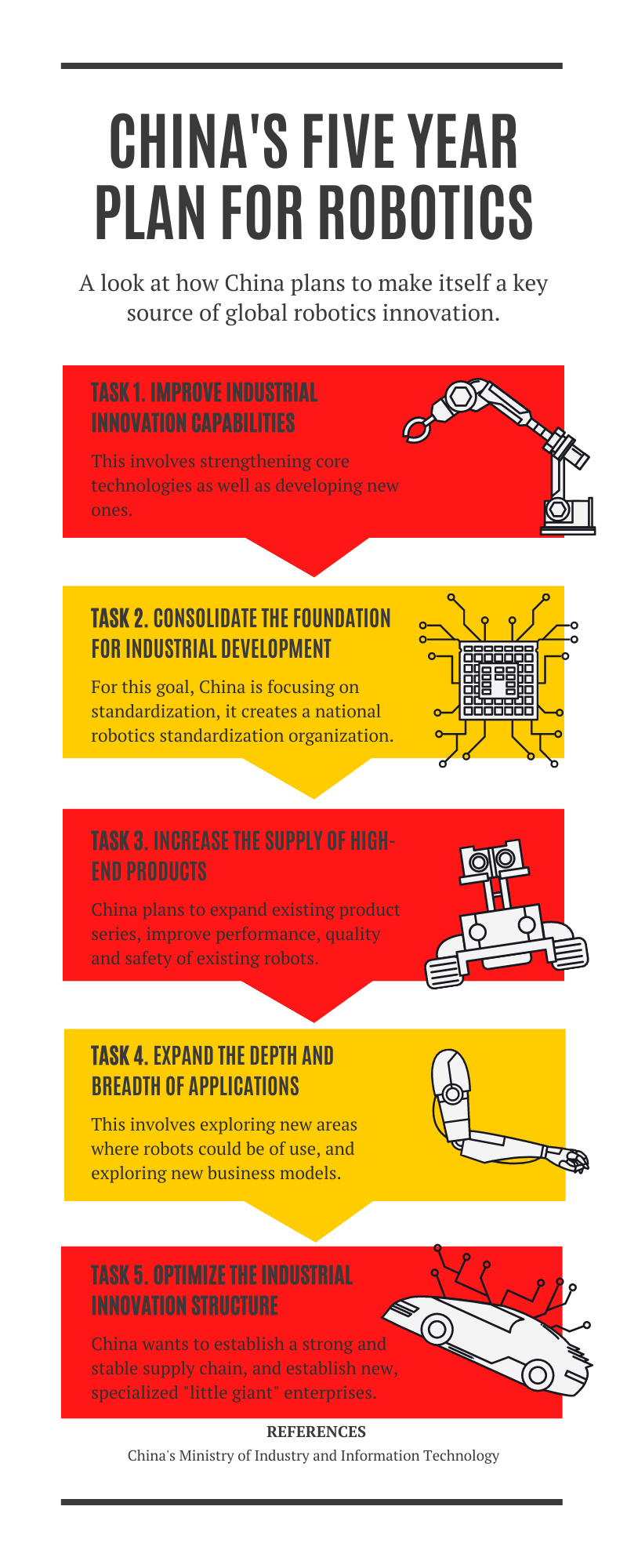Trained robot monitored co-worker’s brain and muscle signals to predict needs, China Three Gorges University team says in domestic peer-reviewed paper
China is in dire need of more powerful robotic technology to address its problems of a shrinking workforce and rising labour costs
Stephen Chen in Beijing
Published: 6 Jan, 2022

Mind-reading robot works with a volunteer in a product assembly experiment.
Photo: Dong Yuanfa, Intelligent Manufacturing Innovation Technology Centre, China Three Gorges University
Researchers in China say they have developed an industrial robot that can read a human co-worker’s mind with 96 per cent accuracy.
The robot not only monitored the worker’s brain waves, but also collected electric signals from muscles, as it worked seamlessly together to assemble a complex product, according to its developers at China Three Gorges University’s Intelligent Manufacturing Innovation Technology Centre.
The co-worker did not need to say or do anything when they needed a tool or a component, as the robot would recognise the intention almost instantly, picking up the object and putting it on the workstation, according to the developers.
“In modern industrial manufacturing, assembly work accounts for 45 per cent of the total workload, and 20-30 per cent of the total production cost,” project lead scientist Dong Yuanfa and his co-researchers said in a paper published in domestic peer-reviewed journal China Mechanical Engineering
Researchers in China say they have developed an industrial robot that can read a human co-worker’s mind with 96 per cent accuracy.
The robot not only monitored the worker’s brain waves, but also collected electric signals from muscles, as it worked seamlessly together to assemble a complex product, according to its developers at China Three Gorges University’s Intelligent Manufacturing Innovation Technology Centre.
The co-worker did not need to say or do anything when they needed a tool or a component, as the robot would recognise the intention almost instantly, picking up the object and putting it on the workstation, according to the developers.
“In modern industrial manufacturing, assembly work accounts for 45 per cent of the total workload, and 20-30 per cent of the total production cost,” project lead scientist Dong Yuanfa and his co-researchers said in a paper published in domestic peer-reviewed journal China Mechanical Engineering
Collaborative robots, or “cobots”, could accelerate the pace of an assembly line, but their application remained limited because “their ability to recognise human intention is often inaccurate and unstable”, the paper said.
Humans and robots or autonomous machines have been working together in factories for decades, but are separated by fences in most places to avoid accidents.
In recent years, some advanced production plants such as car factories in Germany have introduced a fence-free work environment, with robots that swing into action only after a button is pressed. Such machines are equipped with safety sensors that stop them immediately if they come into physical contact with humans.
The robots replacing humans in China’s service industry
Some research teams have tried to build a new generation of “cobots” that can guess human intention by monitoring eye or body movements. However, these passive approaches suffered from problems like slow response and poor accuracy.
To overcome this, the robot created by Dong’s team was put through hundreds of hours of training by eight volunteers.
The volunteers were first asked to wear a non-invasive brain wave detector and the team found the robot could estimate their intent with just about 70 per cent accuracy.
However, the brain signal was quite weak. For the robot to get a clear message, the volunteer would need to concentrate very hard on the work at hand. But most of them were distracted by other thoughts after working on the repetitive assembly job for a while, the researchers said.
In contrast, the muscle signals, collected by a few sensors stuck to an arm, were more stable. Even though these too waned as the volunteer grew tired, a combination of both brain and muscle signals could help the robot estimate the worker’s next move in a second with unprecedented accuracy, according to the team.
01:49
Robot ‘coach’ helps Chinese curlers prepare for Beijing 2022 Winter Olympics
However, it was unclear whether these laboratory results could be replicated in a real-life factory setting. The researchers could not be reached for comment by the time of publication.
According to the paper, there would be some challenges to the application of the new technology in a real factory setting. Though the brain and muscle detectors could be placed inside a worker’s cap and uniform, the quality of data could be affected by sweat or irregular movements.
But these problems could be overcome by feeding the robot with motion and visual data, the researchers suggested.
This comes days after China announced an ambitious plan to become a global innovation hub for robotics by 2025, as part of its “smart manufacturing” goals.
Chinese scientists’ robot fish could pave way for low-cost prosthetics
18 Sep 2021

The number of industrial robots in China has been growing at a pace of 15 per cent annually since 2016, Wang Weiming, director of industrial equipment with the Ministry of Industry and Information Technology, said in Beijing on Tuesday.
There were 246 robots for every 10,000 workers in China, or twice the world average, Wang said, but the majority were built with technology developed in the West that sometimes could not cope with the challenging environments in China.
Hence, China is in desperate need of more powerful robotic technology to overcome problems such as a shrinking labour force amid sharply declining birth rates, and rising labour costs. By 2025, more than 70 per cent of large-scale factories in China would be using robots, he added.
Song Xiaogang, secretary general of the China Robot Industry Alliance, said the development of cobots would be a priority.
“There would be a leap from fence operation to robot-human collaboration,” he told the same press conference.
Some Chinese factories have asked workers to wear brain-reading helmets or use AI-controlled cameras to monitor their facial expressions.
Though the purpose was to detect fatigue, depression or other mental signs that might affect work efficiency or safety, critics have warned about privacy concerns.
In the United States, the use of robots has reduced industrial workers’ salaries, according to a study by the American Economic Association in 2019. Some studies by Chinese researchers in major economic zones such as the Pearl River Delta have found a similar phenomenon.
However, a study by Peking University researchers last month indicated that the mass application of robots in nearly 300 cities from 2006 to 2016 had helped Chinese factories produce more premium products of higher quality and increased the nation’s global competitiveness as a whole.

Stephen Chen investigates major research projects in China, a new power house of scientific and technological innovation. He has worked for the Post since 2006. He is an alumnus of Shantou University, the Hong Kong University of Science and Technology, and the Semester at Sea programme which he attended with a full scholarship from the Seawise Foundation.
How realistic is China’s five-year plan for robotics?
By Georg Stieler | January 3, 2022
https://www.therobotreport.com/
The new five-year plan for the robotics industry is principally a good sign for China’s robotics industry. Whereas other parts of the Chinese technology sector have been hit by stricter regulatory measures in the past year, this plan highlights the ongoing political support for this field.
Whereas the Chinese government seems skeptical about much of the consumer internet, it wants to make China an industrial powerhouse, and robots are a part of this. This trend is also reflected by the fact that Chinese venture capital (VC) investments in robotics almost doubled in 2021 compared to 2020. VC funds in general raised 65% less capital during this period.
Regarding the goals and the question of how realistic they are, I expect a mixed outcome. We should not forget that this is not the first plan of this kind. The first five-year plan for the robotics industry was released in April 2016, about one year after the Made in China 2025 strategy.
Together with plenty of initiatives on provincial and city levels, the subsidies in the wake of Made in China 2025 turned out to be more of a curse than a blessing for the domestic robotics industry, however. Political connections often mattered more than technical capabilities for the distribution of subsidies. Huge overcapacities for the assembly of robot arms were built up, while the development of key components such as reducers, servos and controllers was neglected. Domestic robot companies were trapped in a vicious cycle of low technical capabilities and no margins at the low end of the value chain, leaving no space for investments in R&D.
Correspondingly, we didn’t see the market share of domestic robot makers grow for a long time, it has been around 30-35% over the last few years. The change was only in 2021, when we saw that local companies such as EFORT or ESTUN started winning tender offers against globally leading robot suppliers at renowned clients such as BYD or Foxconn. With extremely low prices, domestic makers of collaborative robots such as JAKA or Elite are also becoming more visible in low- and mid-end applications. The field of Kiva-like AGVs is dominated by local firms.

Speaking about core components, gains of local suppliers were also incremental until recently. Over the last year, we saw that firms such as Inovance (motion control) and Leaderdrive (harmonic gears) were growing stronger than the general market.
Have these recent successes been achieved due to the successful implementation of government planning? Some observers say they came despite the government policies. Domestic companies can only go into price wars when they have corresponding funding. As we have seen in China’s machine tool industry before, huge credit lines can lead to a lack of financial discipline, and prevent companies from becoming competitive in the long run.
The new five-year plan for the robotics industry is principally a good sign for China’s robotics industry. Whereas other parts of the Chinese technology sector have been hit by stricter regulatory measures in the past year, this plan highlights the ongoing political support for this field.
Whereas the Chinese government seems skeptical about much of the consumer internet, it wants to make China an industrial powerhouse, and robots are a part of this. This trend is also reflected by the fact that Chinese venture capital (VC) investments in robotics almost doubled in 2021 compared to 2020. VC funds in general raised 65% less capital during this period.
Regarding the goals and the question of how realistic they are, I expect a mixed outcome. We should not forget that this is not the first plan of this kind. The first five-year plan for the robotics industry was released in April 2016, about one year after the Made in China 2025 strategy.
Together with plenty of initiatives on provincial and city levels, the subsidies in the wake of Made in China 2025 turned out to be more of a curse than a blessing for the domestic robotics industry, however. Political connections often mattered more than technical capabilities for the distribution of subsidies. Huge overcapacities for the assembly of robot arms were built up, while the development of key components such as reducers, servos and controllers was neglected. Domestic robot companies were trapped in a vicious cycle of low technical capabilities and no margins at the low end of the value chain, leaving no space for investments in R&D.
Correspondingly, we didn’t see the market share of domestic robot makers grow for a long time, it has been around 30-35% over the last few years. The change was only in 2021, when we saw that local companies such as EFORT or ESTUN started winning tender offers against globally leading robot suppliers at renowned clients such as BYD or Foxconn. With extremely low prices, domestic makers of collaborative robots such as JAKA or Elite are also becoming more visible in low- and mid-end applications. The field of Kiva-like AGVs is dominated by local firms.

Speaking about core components, gains of local suppliers were also incremental until recently. Over the last year, we saw that firms such as Inovance (motion control) and Leaderdrive (harmonic gears) were growing stronger than the general market.
Have these recent successes been achieved due to the successful implementation of government planning? Some observers say they came despite the government policies. Domestic companies can only go into price wars when they have corresponding funding. As we have seen in China’s machine tool industry before, huge credit lines can lead to a lack of financial discipline, and prevent companies from becoming competitive in the long run.
Can China pick the right winners?
One of the goals of the new plan is to consolidate the industry and create larger entities. However, it is not entirely clear if the government is good at picking winners.
An example of success is HIKROBOT, the logistics robot branch of HIKVISION, China‘s leading state-owned supplier of video surveillance equipment. Together with Huawei, the companies are working on innovative autonomous navigation solutions, which can work without expensive LiDARs.
Cheaper mobile robots might be a game changer, indeed. The Achilles heel of both these companies is their proximity to the Chinese state and that they are on US entity lists. New technologies such as autonomous navigation require substantial computing power, and no mainland Chinese company is close to being able to produce processors powerful enough to complete these tasks.
An example where close government ties do not necessarily translate into success in the marketplace is Siasun, one of China‘s oldest and largest state-owned robot manufacturers. The company had the lowest sales growth among the top 20 robot vendors in China during the last two years.
Takeaways
To conclude, even if many of the goals in this plan are not entirely new and might not be reached in time, both robotics companies and policy makers outside of China need to take the challenge from China’s robotics industry seriously.
Recent developments make me more optimistic about the capabilities of local companies than five years ago. China has increased its number of robotics scientists, many of them educated abroad. The country‘s large industrial base provides plenty of sales potential. In fields such as battery making or photovoltaics, China is so advanced that production knowhow from there is now transferred to other countries. Subsidies and fierce competition in China are bringing down prices, which will pave the way for new robotics applications. Even we expect the economy to cool down further in 2022, but promising robotics companies will continue to receive support.
On the other hand, state-funded Chinese robotics companies are eyeing the US and the EU, hoping to charge higher prices there than in their hyper-competitive home market. Western robotics companies need to be prepared for that. Policy makers must find ways to sustain a healthy development of future industries against competitors, which are enjoying unfair state aid.
Last, but not least: policy makers in the West need to ask themselves what they can do to create a better environment for technology companies on their side. Speaking as a German citizen, our government should be reminded that the fight against climate change is important, but that there are also other pressing issues. Too many resources are being spent for unproductive activities, these days. When were the last attempts to unleash more creative, entrepreneurial power and encourage risk takers in the EU?
About the author
Georg Stieler is managing director for Asia at international consulting firm STM Stieler.

No comments:
Post a Comment